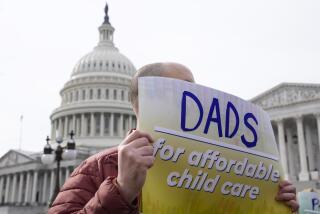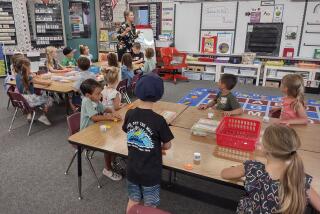Scary Preschool Utopia
Did you know, the earnest lady asked, that one-quarter of even the affluent children in this country start kindergarten without full knowledge of the alphabet?
She clearly found this information a shocker, evidence that this nation needs universal pre-kindergarten, right away. This was, after all, Libby Doggett, the executive director of Pre-K Now, speaking at a seminar for reporters this spring in Denver.
Many parents, myself included, aren’t so worried if our children don’t know all their letters before age 5. Somehow, mine went on to be fine students, and I still harbor hopes that they will become productive citizens despite their early ignorance.
FOR THE RECORD:
Preschool —A June 5 Opinion article on the Reiner initiative reported the title of a children’s book as “Pet the Bunny.” The title is “Pat the Bunny.” Also, though a Washington state study cited did find that home visits by nurses were a better dollar-for-dollar investment than preschools, it did not find that they returned twice as much money per dollar.
From where I sit, it’s much scarier to contemplate the Doggetts of this world setting the agenda for what all 4-year-olds should know.
The value of universal preschool is one of those unquestioned nostrums sweeping the country. The way the question is framed for the public isn’t whether we should love universal preschool, it’s solely whether we’ll pay for it. Now Rob Reiner — actor, director, gadfly — is planning an initiative for the June 2006 ballot. He wants to raise $2.3 billion a year by taxing the well-off and establishing a free, voluntary half-day preschool system for all 4-year-olds in California.
More affordable preschool is a great idea. Preschool can help children learn to play nice, identify colors, get used to the taste of finger-paint and even listen to the teacher occasionally.
But universal preschool isn’t simply “more preschool” or “more affordable preschool.” It’s a species unto itself. Reiner’s initiative would create standardization where now there is parental choice. It would insist on bachelor’s degrees and credentials for teachers — and require, insanely, that they be paid on par with high school science and math teachers, though there’s little evidence that the education or expense is necessary. It would not raise test scores. And it would almost certainly push more and more academic work into the laps of younger and younger children.
Reiner’s preschool utopia would force the state to set “content standards.” and take oversight on such matters as whether to read “Pet the Bunny” or “Goodnight Moon” away from parents and preschools and hand it to education officials.
Parents now choose from a patchwork of public, private, church and family preschools. These reflect the wildly varying interests and needs of children and their families. There are academically oriented preschools and old-time nursery schools. Some focus on learning languages, some on art and some simply on a hearty game of “capture the flag.” They’re warm and cozy in a family living room, or big and exciting at a center with a huge jungle gym, for kids who might go twice a week, or three times, or five. And they’re efficient: Many an excellent preschool costs far less than the $5,900 or so per child the Reiner initiative would spend.
Reiner’s classes would have 20 children, each taught by a teacher and an aide, where now there might be three students, or 12, or in the current state-subsidized system 24 children taught by a teacher and two aides. Even some of the state’s top preschool advocates say it would be hard for home-based family child-care providers to become part of the Reinerian dictate, unless they find a way to join forces to create classrooms of close to 20.
We don’t need this. Preschool is already more “universal” in California than you might think. Somewhere within that patchwork are an estimated 70% of all the 4-year-olds in the state — about 63% in preschool centers, and a handful in family child care. The universal-preschool crowd hopes to raise that to 80%. So to get an additional 10% enrolled, taxes would pick up the bill for the other 70% as well. California’s nonuniversal system already covers a bigger percentage of its 4-year-old population than Georgia’s universal pre-kindergarten system, now in its 12th year.
The universal-preschool crowd’s response is that they’re also about raising quality. Certainly, some teachers need more training — though not a bachelor’s degree. And although plunking a child in front of a TV all day is, as they say in preschool parlance, not OK, that’s a matter of parents checking a place out carefully, not government regulation. Instead of providing standardized classes, better to give sliding-scale vouchers for low-income and working-class families, and educate them on how to tell a good preschool from a bad one. Let parents decide what fits their 4-year-olds, not people with presuppositions about early childhood.
Consider Doggett’s description of what happens in a quality preschool class:
A little boy is happily building with blocks. The teacher (who has a bachelor’s degree, of course) comes up to talk with him about the structure he’s building. She suggests that he bring some model cars over to incorporate with the blocks. If the blocks make a roadway, how would the cars get to the road? In this way, Doggett says, the child is engaged in critical thinking on how to build a ramp. (In reality, he probably decides with the perfect wisdom of his age that cars can fly.)
Some parents might love this little “teachable moment” scenario. I feel like screaming, “For pity’s sake, can’t 4-year-olds play with blocks anymore without some teacher trying to turn them into future transportation planning administrators, GS-12, Level B?”
The Reiner initiative’s “statewide preschool content standards” would be devised by the state schools’ superintendent. These would be “aligned with statewide academic standards” and carried out and supervised by county education departments. It makes you want to weep for those tots.
The universal-preschool people come armed with studies showing that good preschool more than pays for itself, in reduced dropout and teen-pregnancy rates and lower need for special education. Some of this involves a lot of creative-numbers work.
The best studies of preschool looked at programs that involved far more than preschool. They also offered weekly home visitations and other services. Some child-development activists, such as Bob Kirkwood of the Bella Vista Foundation in Palo Alto, think the bigger factor was the visits, not preschool.
A cost-benefit study in Washington state found that each dollar invested in preschool saved taxpayers money down the road — but that a nurse-visitation program for families was twice as good an investment. Parents who are visited tend to seek more education themselves. They learn such child-rearing basics as the importance of cuddling, reading and singing, and are more likely to stay involved in their children’s education. Instead of building bureaucracy, home visits build families. Please don’t tell me that’s “not OK.”
More to Read
Sign up for Essential California
The most important California stories and recommendations in your inbox every morning.
You may occasionally receive promotional content from the Los Angeles Times.











